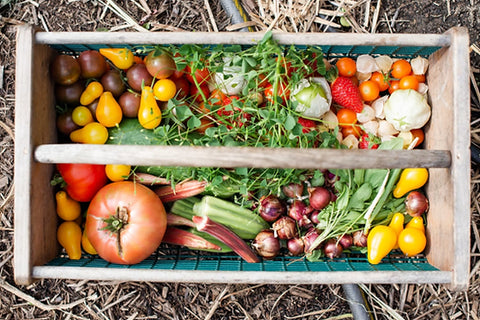Since last week, we have been receiving organic fruits and vegetables produced by La Brouette Maraîchère, a farm located in Saint-Basile-le-Grand. Some of their vegetables currently available at the Ahuntsic-Cartierville Market are completely new to some, or little known to others. We have therefore chosen to present them to you in order to inspire you for your next recipes! Good discovery !
1. GARLIC FLOWER
Its name says it, it’s the garlic flower! What differentiates garlic flower from garlic? Its spicy notes are more subtle and its shape is more similar to that of a giant chives.
Very versatile, this vegetable can be eaten both raw and cooked. Raw, it can replace green onion or chives in a salad, sandwich topping or dip. To cook it, we prepare it like asparagus; on the barbecue, steam, sauté, your imagination is the limit!
Store in the refrigerator in a plastic bag for up to 1 month. Just like garlic bulbs, you can also increase its longevity up to 1 year by freezing it. Combine the chopped garlic flower with olive oil in an ice cube tray and voila! You can add the cubes directly to the pan, to a container in the oven or to the slow cooker to flavor vegetable, meat or fish dishes.
2. KOHLRABI
Coming from a cross between cabbage and wild turnip, this bulb is still little known in North America. Whether pastel green, purple or white, this vegetable is reminiscent of radish in its crunchy texture, but its taste is slightly sweeter. Bonus: the leaves are edible!
Cut into slices, dice, pieces, julienned, grated, raw or cooked, the possibilities seem limitless with kohlrabi!
It is incorporated into delicious purees, soups or stews. This tuber is cooked like a turnip and can take 20-30 minutes to cook. Its taste harmonizes with a wide variety of aromatics; spices, fine herbs, lemon, ginger… Raw, it is served in salad, remoulade or raw vegetables. The leaves are cooked like those of spinach. Although the skin is edible, some choose to peel kohlrabi in order to get rid of the fibrous layer of the vegetable.
To increase its shelf life, remove the leaves and place the kohlrabi in a perforated plastic bag. The bulb will keep for a week in the refrigerator and the leaves for one to two days.
3. THE TAT SELF
A cross between a spinach and a head cabbage would probably give rise to a vegetable with the appearance of tat soi. Just like cabbage and broccoli, this vegetable belongs to the large cruciferous family. Originally from China, tat soi is similar to green bok choy with spoon-shaped leaves. Its taste is reminiscent of broccoli stem. Tat soi microgreens garnish dishes nicely while adding a delicate touch of flavor.
The tat soi is prepared like spinach. Raw, this vegetable is delicious in salads with creamy or Asian vinaigrettes. Chopped, the tender leaves are delicious in sandwich fillings, vegetable purees or potato salads. Cooked, it lends itself equally well to stir-fries and soups.
4. KALE
Very tough and resistant to cold, we could say kale is the Viking of cabbages! Its large curly leaves are rather fibrous and have a pronounced flavor well appreciated by those who know how to prepare it. Only the leaves are edible.
It is very important to prepare the cabbage by removing the core and washing the leaves in running water or vinegar. For the brave who want to eat kale raw, know that massaging for a few minutes with a drizzle of oil is enough to soften the leaves. Kalese pairs well with fruits, especially citrus and apples, and creamy sauces.
Cooked, kale is added to stews, soups, vegetable purees or stir-fries. To soften their taste, it is recommended to blanch the leaves for a few minutes in salt water. It takes 20-30 minutes to steam. Kale chips have been gaining popularity in recent years.
Kale is best stored in a perforated plastic bag in the refrigerator. Once blanched, the leaves are suitable for freezing.
5. CURLY LETTUCE
Did you know that there are over a hundred varieties of lettuce? The curly version is distinguished by its tender green or red leaves which are large and wavy. The folds of leaf lettuce leaves can hide sand or even insects, so it's important to wash them well. Drying the leaves maximizes the adhesion of the seasonings.
--
Sources:
Fortin, J. and Fortin F. (2006). The visual encyclopedia of foods. 688 pages. Montreal. Quebec. Éditions QuébecAmérique.
Shinkaruk, Victoria. (2015, June 24) 7 ways to enjoy garlic scapes [blog post]. Retrieved from https://montreal.lufa.com/fr/blogue/articles/7-facons-de-deguster-la-fleur-d-ail
Association of Quebec Garlic Producers. (2017) Conservation Tips. Retrieved from http://ail.quebec/decouvrez-ail-du-quebec/conservation/



Comments (0)
There are no comments for this article. Be the first one to leave a message!